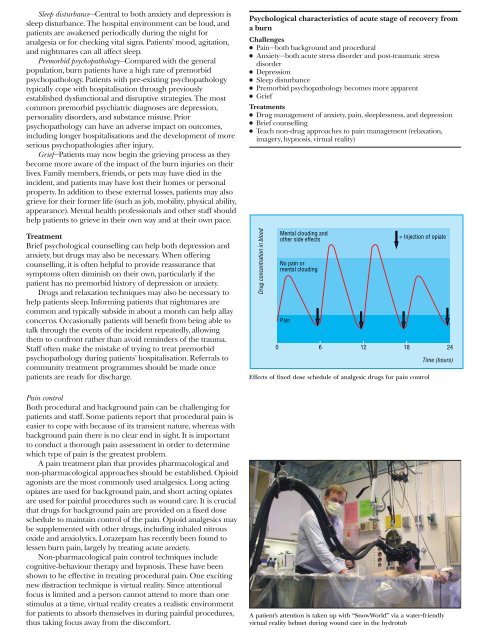ABC of Burns
Create successful ePaper yourself
Turn your PDF publications into a flip-book with our unique Google optimized e-Paper software.
Sleep disturbance—Central to both anxiety and depression is<br />
sleep disturbance. The hospital environment can be loud, and<br />
patients are awakened periodically during the night for<br />
analgesia or for checking vital signs. Patients’ mood, agitation,<br />
and nightmares can all affect sleep.<br />
Premorbid psychopathology—Compared with the general<br />
population, burn patients have a high rate <strong>of</strong> premorbid<br />
psychopathology. Patients with pre-existing psychopathology<br />
typically cope with hospitalisation through previously<br />
established dysfunctional and disruptive strategies. The most<br />
common premorbid psychiatric diagnoses are depression,<br />
personality disorders, and substance misuse. Prior<br />
psychopathology can have an adverse impact on outcomes,<br />
including longer hospitalisations and the development <strong>of</strong> more<br />
serious psychopathologies after injury.<br />
Grief—Patients may now begin the grieving process as they<br />
become more aware <strong>of</strong> the impact <strong>of</strong> the burn injuries on their<br />
lives. Family members, friends, or pets may have died in the<br />
incident, and patients may have lost their homes or personal<br />
property. In addition to these external losses, patients may also<br />
grieve for their former life (such as job, mobility, physical ability,<br />
appearance). Mental health pr<strong>of</strong>essionals and other staff should<br />
help patients to grieve in their own way and at their own pace.<br />
Treatment<br />
Brief psychological counselling can help both depression and<br />
anxiety, but drugs may also be necessary. When <strong>of</strong>fering<br />
counselling, it is <strong>of</strong>ten helpful to provide reassurance that<br />
symptoms <strong>of</strong>ten diminish on their own, particularly if the<br />
patient has no premorbid history <strong>of</strong> depression or anxiety.<br />
Drugs and relaxation techniques may also be necessary to<br />
help patients sleep. Informing patients that nightmares are<br />
common and typically subside in about a month can help allay<br />
concerns. Occasionally patients will benefit from being able to<br />
talk through the events <strong>of</strong> the incident repeatedly, allowing<br />
them to confront rather than avoid reminders <strong>of</strong> the trauma.<br />
Staff <strong>of</strong>ten make the mistake <strong>of</strong> trying to treat premorbid<br />
psychopathology during patients’ hospitalisation. Referrals to<br />
community treatment programmes should be made once<br />
patients are ready for discharge.<br />
Psychological characteristics <strong>of</strong> acute stage <strong>of</strong> recovery from<br />
a burn<br />
Challenges<br />
x Pain—both background and procedural<br />
x Anxiety—both acute stress disorder and post-traumatic stress<br />
disorder<br />
x Depression<br />
x Sleep disturbance<br />
x Premorbid psychopathology becomes more apparent<br />
x Grief<br />
Treatments<br />
x Drug management <strong>of</strong> anxiety, pain, sleeplessness, and depression<br />
x Brief counselling<br />
x Teach non-drug approaches to pain management (relaxation,<br />
imagery, hypnosis, virtual reality)<br />
Drug concentration in blood<br />
Mental clouding and<br />
other side effects<br />
No pain or<br />
mental clouding<br />
Pain<br />
= Injection <strong>of</strong> opiate<br />
0 6 12 18 24<br />
Effects <strong>of</strong> fixed dose schedule <strong>of</strong> analgesic drugs for pain control<br />
Time (hours)<br />
Pain control<br />
Both procedural and background pain can be challenging for<br />
patients and staff. Some patients report that procedural pain is<br />
easier to cope with because <strong>of</strong> its transient nature, whereas with<br />
background pain there is no clear end in sight. It is important<br />
to conduct a thorough pain assessment in order to determine<br />
which type <strong>of</strong> pain is the greatest problem.<br />
A pain treatment plan that provides pharmacological and<br />
non-pharmacological approaches should be established. Opioid<br />
agonists are the most commonly used analgesics. Long acting<br />
opiates are used for background pain, and short acting opiates<br />
are used for painful procedures such as wound care. It is crucial<br />
that drugs for background pain are provided on a fixed dose<br />
schedule to maintain control <strong>of</strong> the pain. Opioid analgesics may<br />
be supplemented with other drugs, including inhaled nitrous<br />
oxide and anxiolytics. Lorazepam has recently been found to<br />
lessen burn pain, largely by treating acute anxiety.<br />
Non-pharmacological pain control techniques include<br />
cognitive{behaviour therapy and hypnosis. These have been<br />
shown to be effective in treating procedural pain. One exciting<br />
new distraction technique is virtual reality. Since attentional<br />
focus is limited and a person cannot attend to more than one<br />
stimulus at a time, virtual reality creates a realistic environment<br />
for patients to absorb themselves in during painful procedures,<br />
thus taking focus away from the discomfort.<br />
A patient’s attention is taken up with “SnowWorld” via a water-friendly<br />
virtual reality helmet during wound care in the hydrotub



